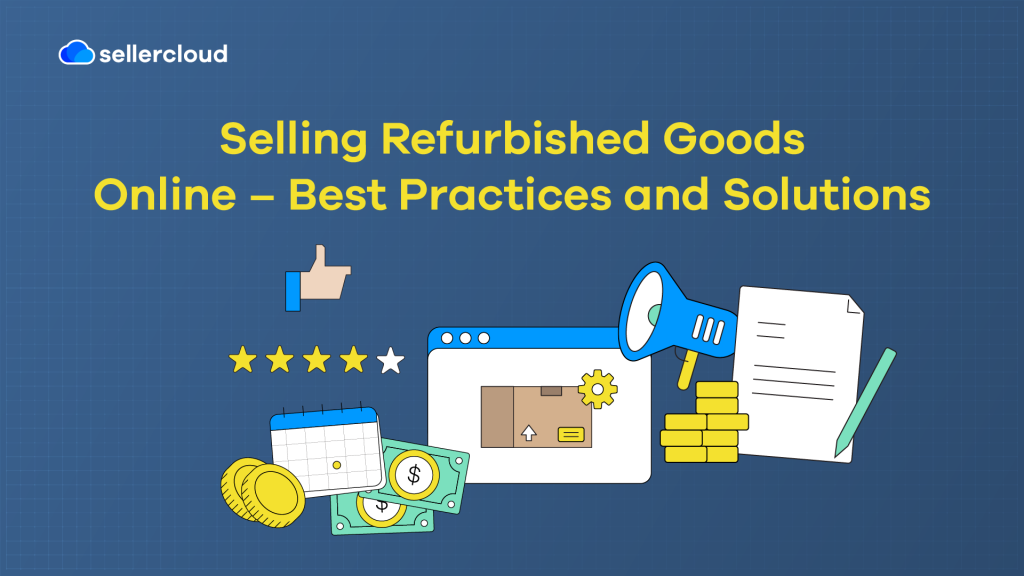
- Yes, sellers can profit from the refurbished goods market. Growing at an exceptional rate, it is one of the hottest industries to enter, especially if you already sell electronics.
- Descartes Sellercloud is the engine of your ecommerce refurbishment business. It connects you to the top refurbished goods marketplaces and enables you to grade your products.
The product life cycle doesn’t end when the initial buyer is finished with the product. Increasingly, used or damaged electronic devices are being refurbished by specialists who breathe new life into them and resell them for profit.
The refurbished goods market is booming. According to a report by Coherent Market Insights, “The global refurbished electronics market size was estimated at US$ 48.29 Billion in 2023 and is expected to reach US$ 94.10 Billion by 2030.” However, others estimate that the refurbished goods market may be much larger. A report by IMARC suggests that the global refurbished goods market may have reached $123.7 billion in 2023 and could reach $314.5 billion by 2032.
The refurbished goods market is also an excellent way to supplement an electronics business, diversify your sales, and reach new customers.
In this article, we’ll define refurbished products, their pros and cons, why the refurbished goods market is growing, and how to get involved.
Is the Refurbished Goods Market Profitable?
Yes, the refurbished goods market is highly profitable, especially in the last few years, as its popularity has risen. According to Statista data, the estimated revenue from consumer electronics was $55.61 billion in 2022 and is expected to more than double to $119.77 billion in 2026.
However, while consumer electronics is the most profitable refurbished goods category, other categories are also well-known as profitable and expected to grow. According to the same data, the next two largest refurbished goods categories after consumer electronics are DIY & hardware, estimated to rise from $24.49 billion in 2022 to $72.6 billion in 2026, and furniture, estimated at $12.44 billion in 2022 and expected to hit $31.59 billion by 2026.
Smaller categories also worth noting are accessories, footwear, toys, hobbies, and video games. There is also a growing market for refurbished luxury goods, so even if refurbished consumer electronics are not your thing, there are other avenues into this industry.
What Defines Refurbished Products?

When businesses discuss ‘refurbished products,’ they often refer to refurbished electronics, which were previously owned and fixed to resemble how they originally looked and functioned. The term ‘refurbish,’ according to Merriam-Webster, means ‘to brighten or freshen up’ or ‘renovate.’
Sometimes, a refurbished product needs minor cosmetic enhancement to remove scuffs or dents to make it appear new. Other times, a refurbished product may have had problems with its mechanics or software and was returned to the manufacturer from its original owner because it needed repair.
Refurbished products are not always pre-owned devices; they can sometimes be devices used as display items. However, it’s essential to clearly distinguish what makes a product refurbished, renewed, used, secondhand, or reconditioned.
What Is the Difference between Refurbished and ‘Renewed’?
A renewed product is one the owner returned, is barely used, and doesn’t need repair. It is checked to see if it works and then put back on for sale. Renewed products are practically new and likely only need new packaging. They can also be referred to as ‘open-box.’
Refurbished goods require much more effort. They need someone to work on them to fix cosmetic and functional problems. Refurbished products were used more. They can even be models that are not even produced anymore.
What Is the Difference between Refurbished and ‘Used’?
Used products can also be referred to as ‘pre-owned’ or ‘secondhand.’ They are products that have been sold to the seller and have not had any kind of repair like refurbished goods—they are simply checked to see if they work and sold on.
Refurbished products are repaired to a ‘like new’ level, while used ones are sold as the seller receives them. Used products are not usually checked for defects before they are sold.
What Is the Difference between Refurbished and ‘Reconditioned’?
Refurbished and reconditioned are very similar terms, almost synonymous. Arguably, the difference is that reconditioned products go through a higher level of repair and more testing. Other similar terms to refurbished or reconditioned include ‘recertified,’ ‘repaired,’ and ‘refreshed.’
What Refurbished Goods Are Most Popular?
Cell phones, laptops, and tablets are some of the most popular refurbished goods. According to a 2023 article by Scott Edwards and Pennsylvania State University, “Businesses have invested more than $100 billion in the production of refurbished products in the U.S. today, up from $37.3 billion in 2009.”
Regarding cell phones, an Allied Market Research report stated that “The global refurbished and used mobile phones market size was valued at $52 billion in 2021, and is projected to reach $145.9 billion by 2031, growing at a CAGR of 11.2% from 2022 to 2031.”
Elsewhere, Future Market Insights states that the market value of refurbished laptops is projected to increase from approximately $17 billion in 2023 to $47 billion by 2033.
What Are the Pros and Cons of Selling Refurbished Products?
Selling refurbished goods is not without its challenges. While there is plenty to gain, you must be aware of the potential pitfalls.
Pros
- Refurbished electronics can be discontinued models that are no longer produced, allowing consumers to find specific features or specifications they prefer.
- Refurbished goods appeal to consumers who take sustainability seriously. By selling such products, you increase the likelihood of such shoppers buying from you.
- Consumers trust refurbished goods more than ever, and as a rapidly growing market, electronics sellers can diversify their sales.
- Lower prices make refurbished products more appealing to consumers. Many customers are looking to grab what they see as a good deal.
Cons
- Refurbished inventory is limited, especially for popular or in-demand models, making it challenging to source specific devices. You may go through periods when you are unable to source specific models.
- There’s always the chance that refurbished goods have hidden defects. You likely will not know who owned the device before and what the problem was with it.
- Some customers will always assume that refurbished devices are of lower quality than brand-new ones, so they will avoid buying them (though, in some cases, refurbished devices are tested more than new products).
- You must adequately vet suppliers of refurbished devices for quality and counterfeit products to avoid customer issues.
Why Is the Refurbished Goods Market Growing?
The refurbished goods market has made extraordinary leaps in the last several years because of the advancement of refurbishment techniques, new technologies, and diagnostic tools. It is now more possible than ever to repair a device, rebuild it as close as possible to how it originally looked and worked, and sell it at a discounted price.
Manufacturers are also more involved and supportive of the refurbished products market. Enabling people and businesses to refurbish goods. Some have even gotten directly involved in the refurbishment business. For example, Apple launched its own store to sell its refurbished goods (iPhones, Macs, iPads, and other devices).
Refurbished goods are more likely to come with warranties and better consumer protection than before, which has helped win over consumer trust, as they know if there is an issue, they can return the item. This has helped the refurbished goods market flourish in the 2020s and become trendy among bargain hunters.
Why Do Customers Buy Refurbished Goods?
Sustainability is a major reason customers seek refurbished goods. Many customers are concerned about the environment, and purchasing refurbished products is a way they can reduce e-waste (electronic waste). They may actively seek out refurbished goods when shopping online.
Because of this, there is less stigma associated with refurbished (and secondhand) goods than before. Before, customers would be concerned about what people might think about purchasing such products.
These days, people even take pride in purchasing refurbished goods, and many are okay with receiving secondhand products as gifts. According to a study, 82% of people were open to receiving secondhand holiday gifts in 2023, up 11% from 2022.
However, while sustainability receives considerable attention when discussing refurbished goods, many consumers are actually looking to save money on a deal. A Liquidity Services, Inc. survey found that “80% consider price important when choosing electronics,” and “96% believe that buying refurbished products will save them money.”
Furthermore, following the pandemic, economic uncertainty led cautious consumers to spend more on refurbished or even used products because they were cheaper.
How Do You Get Involved in the Refurbished Goods Business?
You can get involved in the refurbished goods market in one of two ways: resell refurbished goods from another company or start refurbishing and selling them yourself. Either way, you should be knowledgeable about refurbished products and the electronics market.
If you buy from someone who refurbishes goods, ensure they are properly tested and come from a reliable source. You must vet your vendors and have an AVL (Approved Vendor List). If you do the refurbishment, you must invest in the right equipment, hire professionals with experience in refurbishment, and order the parts you need when refurbishing items.
Can Anyone Sell Refurbished Goods?
Technically speaking, anyone can get into the refurbishment goods business; however, always ensure you talk to the original manufacturer and understand their requirements. You may need a certificate from a manufacturer before you can refurbish their goods, or they might not accept any of their products to be refurbished by your business.
You may be required to complete a test and sign an agreement to get this certificate. For manufacturers where approval is required, if you don’t have approval, you’ll only be able to sell the product as used.
Which Marketplace Is the Best for Refurbished Goods?
Traditionally, eBay is well-known as a marketplace for selling refurbished goods. However, as the refurbished goods market has grown in recent years, new marketplaces that cater specifically to this niche have emerged—Reebelo, Mercari, and Back Market, for example. However, this doesn’t mean these are the only marketplaces where you can sell refurbished goods.
Can You Sell Refurbished Items on Amazon?
Amazon has a dedicated platform for refurbished goods called Amazon Renewed. To sell on Amazon Renewed, you must already be an Amazon seller and meet their requirements for a refurbished seller. It’s also worth noting that Walmart has made strides in the refurbished goods industry with Walmart Restored.
How Do You Price Refurbished Products?
Properly pricing refurbished items can be tricky. The same device can be refurbished in different ways depending on the repairs needed, and it can impact the end quality and, therefore, the price. As you’d expect, better-quality refurbished items are often priced higher, while lower-quality refurbished items are generally priced lower.
A high-quality refurbished product could practically be brand new, while a lower-quality refurbished product may have minor defects that cannot be repaired. You may have several refurbished models of the same product, but each requires a different level of refurbishment, which results in a different level of quality.
In this case, having a grading system to categorize them is good. Products of a higher category can be assigned a higher price, and products of a lower category level can be assigned a lower price. This also gives consumers options.
Your pricing strategy should cover the cost of the device and the cost to refurbish the product while also considering market demand and the fact that, depending on their condition, some devices will cost more than others to refurbish.
Furthermore, it is also helpful if your pricing strategy is reactive to the wider market so you can price your refurbished products competitively according to your competitors’ prices.
How Do You Market Refurbished Products?
There are quite a few ways businesses can market their refurbished products. Whatever approach you take, it is wise to focus your marketing efforts on why consumers purchase refurbished products.
Often, it is a good idea to emphasize the deal. Consumers are getting something practically brand new for a significant discount. Likewise, as mentioned above, many customers prefer refurbished products because they are more sustainable. However, this may be more reflected in your brand than in how you market products.
If the product you are selling is a unique model with features that more recent versions don’t have, focus on that. Customers may want to replace a broken model they are used to and don’t want to learn how to use a more recent model, or they may be looking for a unique feature that isn’t manufactured anymore.
Always be open to the fact that the product is refurbished. Customers will appreciate transparency, and it will reduce the likelihood of products being returned. Furthermore, clearly displaying that the product is refurbished will help consumers actively looking for such products.
Again, you can focus on the level of refurbishment in your marketing approach or even specifically explain what has been refurbished.
Can You Sell Refurbished Items as New?

Selling refurbished goods as new is not a good idea. Though there is no legal definition of what defines a refurbished product, selling refurbished items as new can be considered fraudulent, and lying to the customer can get you in big trouble.
Marketplaces may ban your business from selling on their platform if you lie about the quality of your products. Transparent sellers will always last longer than those who bend the truth. Additionally, when refurbishing the product, you should use the exact parts from the manufacturer for the exact model.
If the product requires a new operating system, use the one that originally came with the device and let the customer do the updates themselves. Plus, you should be sure to wipe any data from the product left by the previous owner adequately.
Should Refurbished Goods Have a Warranty?
Yes, refurbished products should have a warranty. However, it is often shorter than that of a new product because the device is more likely to have faults. Providing customers with a warranty can make them feel more confident about their purchase as they know it can be returned if there is an issue.
How Can Refurbished Goods Sellers Maximize Their Potential with Descartes Sellercloud?
Descartes Sellercloud operates as the beating heart of your refurbished goods business, covering every aspect of your operations, from order and inventory management to product listings, shipping, reporting, and everything in between.
For refurbished products, you can grade them depending on their condition and price them accordingly, helping you manage your different refurbished listings and inventory. Furthermore, Descartes Sellercloud is integrated with the top refurbished goods marketplaces—Back Market and Reebelo—and top ecommerce marketplaces, such as Amazon, eBay, and Walmart.
Learn how Descartes Sellercloud and Skustack helped Revive IT grow its refurbished products business.
Book a demo today to discover how Descartes Sellercloud can help grow your refurbished goods business.
Key Points
You now have a solid understanding of the refurbished goods industry to jump in head first. Make sure you remember these key points.
- Refurbished goods are used products that have been repaired to a ‘like-new’ condition and sold to customers. They are not the same as renewed or used products, though you may call refurbished goods repaired, reconditioned, or refreshed.
- In recent years, advancements in refurbished goods technology and diagnostics have helped the industry balloon. Many manufacturers also refurbish their older models.
- Consumers purchase refurbished goods because they are seen as more sustainable than new products and often much cheaper.
- Marketing and pricing refurbished goods can be tricky. Refurbished goods should clearly state that they are refurbished and should be priced according to their condition.
- Descartes Sellercloud is the ideal ecommerce solution for refurbished sellers because it enables them to grade their products and sell them on the best ecommerce marketplaces from one interface.





